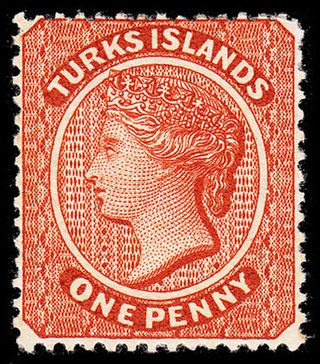
Caribbean cuisine is a fusion of West African, Creole, Amerindian, European, Latin American, Indian/South Asian, North American, Middle Eastern, and Chinese. These traditions were brought from many countries when they moved to the Caribbean. In addition, the population has created styles that are unique to the region.

The Turks and Caicos Islands are a British Overseas Territory consisting of the larger Caicos Islands and smaller Turks Islands, two groups of tropical islands in the Lucayan Archipelago of the Atlantic Ocean and northern West Indies. They are known primarily for tourism and as an offshore financial centre. The resident population in 2023 was estimated by The World Factbook at 59,367, making it the third-largest of the British overseas territories by population. However, according to a Department of Statistics estimate in 2022, the population was 47,720.

The Antilles is an archipelago bordered by the Caribbean Sea to the south and west, the Gulf of Mexico to the northwest, and the Atlantic Ocean to the north and east.
Caribbean English is a set of dialects of the English language which are spoken in the Caribbean and most countries on the Caribbean coasts of Central America and South America. Caribbean English is influenced by but is distinct to the English-based creole languages spoken in the region. Though dialects of Caribbean English vary structurally and phonetically across the region, all are primarily derived from British English and West African languages. In countries with a plurality Indian population, such as Trinidad and Tobago and Guyana, Caribbean English has further been influenced by Hindustani and other South Asian languages.

A Spanish creole, or Spanish-based creole language, is a creole language for which Spanish serves as its substantial lexifier.

The English-speaking world comprises the 88 countries and territories in which English is an official, administrative, or cultural language. In the early 2000s, one billion to two billion people spoke English, making it the largest language by number of speakers, the third largest language by number of native speakers, and the most widespread language geographically. The countries in which English is the native language of most people are sometimes termed the Anglosphere. Speakers of English are called Anglophones.
Samaná English is a variety of the English language spoken by descendants of black immigrants from the United States who have lived in the Samaná Peninsula, now in the Dominican Republic. Members of the enclave are known as the Samaná Americans.
Virgin Islands Creole, or Virgin Islands Creole English, is an English-based creole consisting of several varieties spoken in the Virgin Islands and the nearby SSS islands of Saba, Saint Martin and Sint Eustatius, where it is known as Saban English, Saint Martin English, and Statian English, respectively.
Anguillan Creole is a dialect of Leeward Caribbean Creole English spoken in Anguilla, an island and British Overseas Territory in the Caribbean. Although classified as a dialect of Leeward Caribbean Creole English spoken in Saint Kitts and Nevis, Antigua and Montserrat due to a common British colonial history, it is actually closer to the British Virgin Islands and Saint Martin varieties of Virgin Islands Creole. The number of speakers of Anguillan Creole is below 10,000. Anguillan Creole does not have the status of an official language.

Providenciales is an island in the northwest Caicos Islands, part of the Turks and Caicos Islands, a British Overseas Territory. The island has an area of 98 km2 (38 sq mi) and a 2012 Census population of 23,769. Providenciales is the third largest island in the Turks and Caicos in area, and is home to a large majority of the population of the Turks and Caicos Islands.
Bahamian Creole, also described as the Bahamian dialect, is spoken by both white and black Bahamians, although in slightly different forms. Bahamian dialect also tends to be more prevalent in certain areas of the Bahamas. Islands that were settled earlier or that have a historically large Afro-Bahamian population have a greater concentration of individuals exhibiting creolized speech; the dialect is most prevalent in urban areas. Individual speakers have command of lesser and greater dialect forms.
Rama Cay Creole is a Creole language spoken by some 800 to 900 people on the island of Rama Cay in eastern Nicaragua. It is based on Miskito Coast Creole with additional elements of the Chibchan language Rama and purportedly some elements of English spoken with a German accent. The creolization of the language is supposed to have happened when Moravian missionaries who were native Germans but preached in English encouraged the Rama-speaking population of the island to shift to English.
The languages of North America reflect not only that continent's indigenous peoples, but the European colonization as well. The most widely spoken languages in North America are English, Spanish, and to a lesser extent French, and especially in the Caribbean, creole languages lexified by them.

The following outline is provided as an overview of and topical guide to the Turks and Caicos Islands:

The following is an alphabetical list of topics related to the British Overseas Territory of the Turks and Caicos Islands.

Lesbian, gay, bisexual, and transgender (LGBT) persons in the British Overseas Territory of the Turks and Caicos Islands face legal challenges not experienced by non-LGBT residents. Same-sex sexual activity has been legal in the Turks and Caicos Islands since 2001, and discrimination based on sexual orientation is constitutionally banned.

Postage stamps have been issued in the Turks and Caicos Islands since 1867.

Sharlene Linette Cartwright-Robinson JP is a Turks and Caicos Islander politician and lawyer who served as the 4th Premier of the Turks and Caicos Islands from 20 December 2016 to 20 February 2021. She was the territory's first female premier. She was also the first woman to become first, deputy head, and then, head of the People's Democratic Movement (PDM).
The Our Lady of Divine Providence Church, Providenciales is a Catholic place of worship on Providenciales, an island of Turks and Caicos in the Caribbean.








